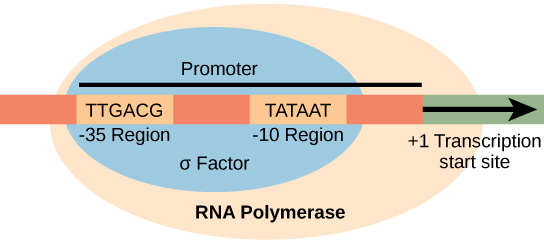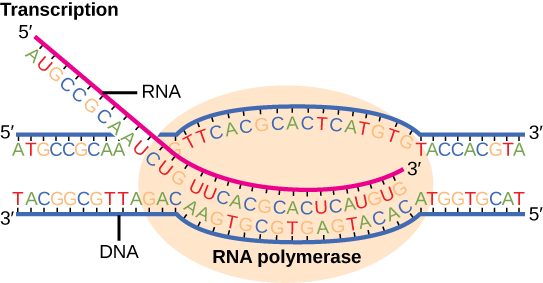13.2 Prokaryotic Transcription
Bacteria and Archaea are mostly single-celled organisms that lack membrane-bound nuclei and membrane-enclosed organelles. A bacterial chromosome is a closed circle that, unlike eukaryotic chromosomes, is not organized around histone proteins. In addition, prokaryotes often have plasmids, which are shorter, circular DNA molecules that may only contain one or a few genes.

Transcription
Transcription of a gene begins when RNA polymerase binds to DNA at the promoter for that gene. A promoter is a DNA sequence onto which the transcription machinery, including RNA polymerase, binds and initiates transcription. In most cases, promoters exist upstream of the genes they regulate.

Transcription requires the DNA double helix to partially unwind in the region of mRNA synthesis. The region of unwinding is called a transcription bubble. Transcription always proceeds from the same DNA strand for each gene, which is called the template strand. The mRNA product is complementary and antiparallel to the template strand and is almost identical to the other DNA strand, called the nontemplate strand, or the coding strand. The only nucleotide difference is that in mRNA, all of the T nucleotides are replaced with U nucleotides. In an RNA double helix, A can bind U via two hydrogen bonds, just as in A–T pairing in a DNA double helix.

Regulation of Transcription
The DNA of prokaryotes is organized into a circular chromosome. Proteins that are needed for a specific function, or that are involved in the same biochemical pathway, are often encoded together in blocks called operons. For example, all of the genes needed to use lactose as an energy source are coded next to each other in the lactose (or lac) operon, and transcribed into a single mRNA.
In prokaryotic cells, there are three types of regulatory molecules that can affect the expression of operons: repressors, activators, and inducers. Repressors and activators are proteins produced in the cell. Both repressors and activators regulate gene expression by binding to specific DNA sites adjacent to the genes they control. In general, activators bind to the promoter site, while repressors bind to operator regions. Repressors prevent transcription of a gene in response to an external stimulus, whereas activators increase the transcription of a gene in response to an external stimulus. Inducers are small molecules that may be produced by the cell or that are in the cell’s environment. Inducers either activate or repress transcription depending on the needs of the cell and the availability of substrate.
a molecule of DNA; part or all of the genome. Also refers to the condensed version of chromatin that is found within cells undergoing cell division.
extrachromosomal circular DNA molecule that may contain one or a few genes; common in prokaryotes
DNA sequence to which RNA polymerase and associated factors bind and initiate transcription
region of locally unwound DNA that allows for transcription of mRNA
strand of DNA that is used to make the complementary mRNA molecule; sequence is complementary to the mRNA
strand of DNA that is not used to transcribe mRNA; this strand is identical to the mRNA except that T nucleotides in the DNA are replaced by U nucleotides in the mRNA
collection of genes involved in a pathway that are transcribed together as a single mRNA in prokaryotic cells
protein that binds to the operator of prokaryotic genes to prevent transcription
protein that binds to prokaryotic operators to increase transcription
a molecule that increases gene expression, either by binding to a repressor and inactivating it, or binding to an activator and activating it

